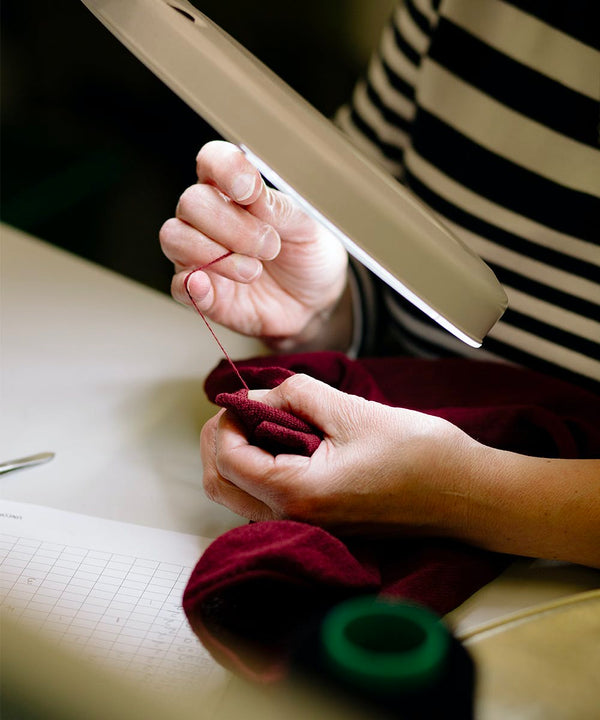
Cashmere Revival with Alexandra Brinck
As part of this year's London Craft Week, we welcomed Cashmere Circle and one of their knitwear experts, Alexandra Brinck , to join us at our Burlington Arcade store, alongside customers and friends of the brand.

It was a day of talks, live cashmere repair and demonstrations to highlight the importance of caring for your knitwear.
Partnering with Cashmere Circle , allows us to offer UK-based customers a luxury, environmentally mindful repair, revive and recycling service, to extend the life of your treasured Begg x Co knitwear, for generations to come.
As part of our journey towards full circularity, we also launched our carefully curated cashmere care kit in-store and online.
We sat down with Alexandra Brinck, a London-based textile designer and repair specialist, who is part of Cashmere Circle's collective of cashmere designers, to hear her thoughts on caring for your cashmere knitwear.
How did you start your journey around mending and caring for cashmere?
The way I see it, knowing how to repair something is just the flip side of knowing how to make it.
I've had a love for textile crafts all my life: I grew up surrounded by skilled craftswomen, so I've been making things for as long as I can remember, and mending things for nearly as long.
As a textile designer, I've been fortunate enough to work in various areas of both craft and design.
As a result, I'm a bit of a textile Jack-of-all-trades, which is probably what you need as a repair specialist!

Why do you enjoy working with cashmere?
I work with all sorts of materials and fibres, but nothing quite compares to working with cashmere.
Aside from the wonderful tactile experience of working with this very precious fibre, cashmere is particularly well suited to being repaired.
The loftiness and halo of the yarn allow repairs to blend into the surrounding fabric really well, resulting in truly invisible mending.
Adding to that, the luxury nature of the fibre means that cashmere garments are often a cut above the rest - and it's always lovely to work with beautifully things that have been well made.

What is invisible mending, and what are the benefits of using this technique?
When a garment is restored with invisible mending, the knitted fabric is replicated perfectly, in order to erase all signs of damage.
Aside from making the garment as good as new again, there is additional benefit to this type of repair because you are not altering the integrity of the fabric.
When a knitted fabric is mended with a woven darn or a patch, the structure of the repair will be different to the surrounding area.
This means that the repair will behave differently to the rest of the garment - for example, one of the main characteristics of a knitted fabric is that it has a certain amount of elasticity built in, which is often essential in garment design.
For example, if you look at a hat or a sock, these are designed with what's called ‘negative ease', meaning that they are actually smaller than the part of the body they are to be worn on, and they stay in place because of being stretched out to fit.
If part of the fabric was now replaced with a woven area, it would affect the fit of the piece.
Of course, this is less of an issue with, say, a jumper - but here you may instead run into issues with the drape of a garment being affected.

What is invisible mending, and what are the benefits of using this technique?
When a garment is restored with invisible mending, the knitted fabric is replicated perfectly, in order to erase all signs of damage.
Aside from making the garment as good as new again, there is additional benefit to this type of repair because you are not altering the integrity of the fabric.
When a knitted fabric is mended with a woven darn or a patch, the structure of the repair will be different to the surrounding area.
This means that the repair will behave differently to the rest of the garment - for example, one of the main characteristics of a knitted fabric is that it has a certain amount of elasticity built in, which is often essential in garment design.
For example, if you look at a hat or a sock, these are designed with what's called ‘negative ease', meaning that they are actually smaller than the part of the body they are to be worn on, and they stay in place because of being stretched out to fit.
If part of the fabric was now replaced with a woven area, it would affect the fit of the piece.
Of course, this is less of an issue with, say, a jumper - but here you may instead run into issues with the drape of a garment being affected.

At the talk in our Burlington Arcade store, the audience discussed the emotional journey of garments and the value of mending – could you tell us a little more about it?
When we talk about mending, we often focus on the financial and environmental benefits.
And while these are obviously important, I also get a lot of commissions where these are not the main motivation.
Aside from being practical objects that protect us from the elements, clothes can also be imbued with additional value and meaning, and clients often entrust me with garments that are far more precious to them than the mere monetary value.
One client handed me a pair of Fair Isle gloves that had belonged to her grandmother and shared with me her childhood memories of walking hand in hand with her granny wearing those gloves.
Another client sent me a jumper for repair and told me that it had belonged to her mother who had passed away, and that her father now wears the jumper to remember his wife.
And of course, there are heirlooms like baby blankets and handknitted jumpers that are passed down through the generations and form part of someone's family history.
Getting to restore pieces like these is a wonderful aspect of my job.
Why is it important to care for our cashmere and ensure a longer life for these garments?
Ideally, we should aim to extend the lifecycle of all clothing regardless of fibre composition or price tag, but when it comes to cashmere there is obviously some additional incentive.
Purchasing a cashmere garment is often a rather different experience than simply buying some everyday clothing; it’s about investing in a beautiful statement piece that will last a long time. And so it makes sense to take a little extra care of how we treat our cashmere.
In the same way we routinely service our cars to make sure they stay in running order, it’s a good idea to keep an eye on your favourite cashmere pieces so that any developing issues can be quickly dealt with. What starts as a tiny hole can soon develop into a much bigger one which may be more difficult to repair successfully. (It really is true what they say about a stitch in time saving nine…)
A well-made cashmere jumper can be a trusty wardrobe stable for decades, but far too often people tell me they’ve thrown out favourite garments with very minor damage because they simply weren’t aware that repair services exist…
Find out more about our Begg x Co + Cashmere Circle Revive and Repair Services or explore our cashmere collections today
Photography: Sophie Stafford
Cashmere Repair FAQs
Can cashmere be repaired?
Yes, cashmere can be repaired. Whether your clothes are needing a minor repair, or a significant amount of revival, the cashmere can be brought back to life.
With the right skills and expertise, cashmere knitwear can be professionally repaired and refinished to make it look like new again. Repairing small holes, snagged threads, or split seams on cashmere garments can help extend their lifespan and reduce the need for replacement, promoting sustainability and reducing environmental impact.
It is important to choose a reputable and experienced garment repair service provider for cashmere repairs to ensure the best results. Our partnership with the expert team at Cashmere Circle is a great option for any treasured cashmere clothing, helping you bring your damaged cashmere to a like-new condition.
How to repair moth holes in cashmere clothing
To repair moth holes in the natural fibres of your cashmere clothing, you can use a cashmere repair service that specialises in mending knitwear, like our cashmere repair service.
The specialist team at Cashmere Circle can expertly repair small holes or split seams, making your wool garments look brand new again. They use artisan techniques based on traditional time-honoured craftsmanship and skills, to invisibly mend holes, remove stains and ultimately revive the natural yarns to ensure your treasured cashmere can be worn for many more years to come.
Additionally, they can provide tips on how to prevent future moth damage, such as storing clothes with cedar blocks to deter moths.
How to fix a cashmere sweater that shrunk
To fix a cashmere sweater that has shrunk, first, try soaking it in lukewarm water mixed with hair conditioner for about 30 minutes. Gently stretch the sweater back to its original size while it is damp.
Avoid wringing or twisting the sweater to prevent further damage. Lay it flat to dry on a towel, reshaping it as needed. If the sweater still feels a bit tight, repeat the process until you achieve the desired size.
Make sure to follow the care instructions provided by the manufacturer to prevent future shrinking.
Other Articles

How to style cashmere - Begg x Co Team Favourites
Introducing our Retail Team, based in our brand home, situated in the heart of Mayfair, London in the prestigious Burlington Arcade. Read more

How to Care for Cashmere Knitwear
Any cashmere clothing or homewear item is an item to treasure. But it’s not always ...

Begg x Co + The Glasgow School of Art
Begg x Co has teamed up with Read more








